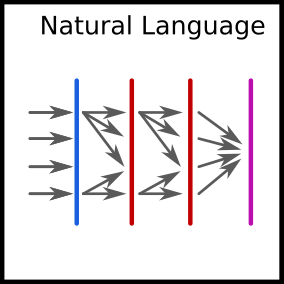Cell atlases are single cell data sets on the scale of whole organisms. There are presumably many ways for humans to query these atlases using natural language (e.g. English), however human-atlas interactions are currently limited to Python or R programmers.
This project enables biologists, doctors, and anyone else to ask questions in their natural language (starting from English) and convert the question into a formalised query for an atlas approximation. This functionality is used internally in our Human Interface web application. Intents understood via NLP in this library are then forwarded to our JavaScript API contained in the atlasapprox npm package.
Exact formats for queries are being defined. For the time being, the working draft of a complete formal query (CFQ), i.e. the expected output of a well-posed question in natural language, is shown in a few examples.
- Q: What is the expression of Ptprc and Col1a1 in mouse lung?
query = {
target: "average",
organism: "m_musculus",
organ: "Lung",
features: ["Ptprc", "Col1a1"],
transform: ["log10", "hierarchical(axis=1)", "hierarchical(axis=1)"],
}- Q: What organisms are available?
query = {
target: "organisms",
}- Q: What organs are available for mouse?
query = {
target: "organs",
organism: "m_musculus",
}- Q: What are the marker genes for alveolar fibroblasts in mouse lung?
query = {
target: "markers",
organism: "m_musculus",
organ: "Lung",
celltype: "alveolar fibroblast",
}This format is related to but richer than the parameter object of the REST API. The latter only includes the necessary information to obtain the data from the backend, whereas this format also specifies any subsequent transformations to be applied (e.g. for plotting, download). Also, the REST API specifies lists of features as a comma-separated string, whereas they are a proper list here.
This format is also related to but not identical to the atlas approximation visualisation data format, which includes not only the query for some data but the data itself (i.e. the answer to the query). Also, this format can be used for other things than visualisation (e.g. for data download).
NOTE: JavaScript used throughout. Trivial conversions into Python dictionaries, JSON, etc. are available of course.
An incomplete query is the result of interpreting a natural language request which is not containing sufficient information to answer it (i.e. to trigger an API call). For instance, the question "What organs are available?" is incomplete because the answer depends on the organism of choice. Examples are as follows:
- Q: What organs are available?
query = {
target: "organs",
missing_parameters: ["organism"],
}- Q: What is the expression of Ptprc?
query = {
target: "average",
features: ["Ptprc"],
missing_parameters: ["organism", "organ|celltype"],
}In this case, multiple aspects are missing from the query, including what organism to look at. Once an organism is specified, the user can choose either an organ (more common) or a cell type across organs.
Early prototypes are using nlpjs which seems to be flexible and powerful enough.
src/corpus.jsonis the training corpus containing utterances (questions), entities, etc.src/app.jscontains most of the wrapper code, including thebuildAPIParams,buildAnswer, andaskfunctions.src/tail_node.jscontains the object constructor and initalisation methods to be exported in CommonJS format.src/tail_window.jsis an older version that relies on a globalwindow.nlpobject (deprecated).
- Add utterances etc. to the corpus.
- Test with
npm run testCorpus, adding test questions totest/trainAndTest.jsif needed. - Once this works, you can pre-train the production model using
npm run train.npm run trainsaves the model ingists/model/model.nlpwhich is a git submodule, and pushed a new commit to the gist repo. - Get the URL of the raw file on gist and substitute it on top of
src/app.js. - Run
npm run testNpmto test a webpack-like app that loads the module using CommonJS.
(deprecated):
npm run testBrowsercreates a browser-compatibleindex.jsand anindex.htmlintobuildand opens it in Firefox. Opening the inspector shows an example call and exposes a function calledanswerFunto probe the model by hand.
